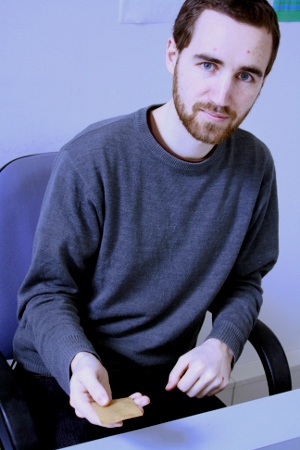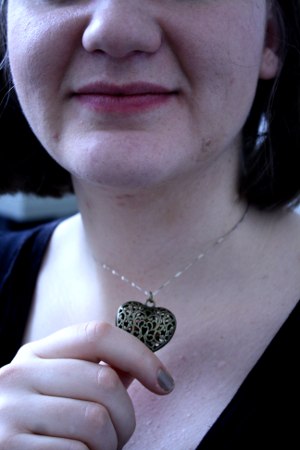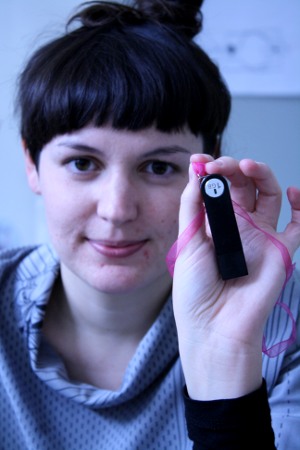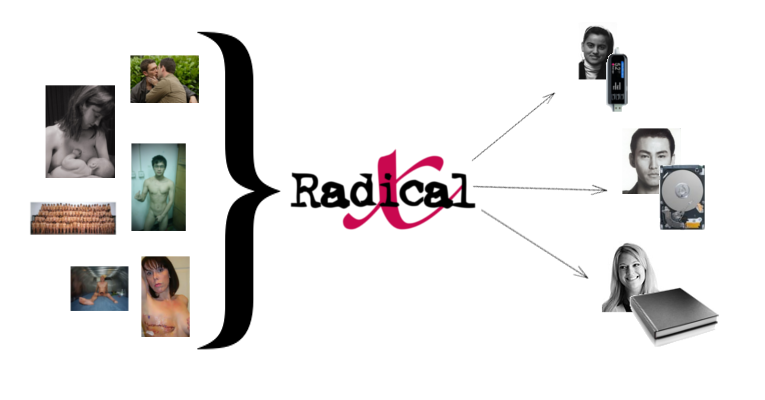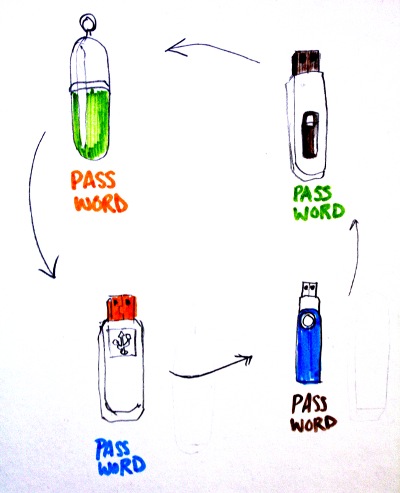User:Eleanorg/Journal 1.2: Difference between revisions
No edit summary |
(→10 Feb) |
||
| Line 1: | Line 1: | ||
__NOTOC__ | __NOTOC__ | ||
==10 Feb== | ==10 Feb== | ||
Good tutorial with Renee. Some kind of girly thing about bodies. | Good tutorial with Renee. Some kind of girly thing about bodies. She even left some kind of foamy coffee thing on my desk... | ||
Thoughts: | Thoughts: | ||
| Line 12: | Line 12: | ||
** Check out Renee's project 'I am Writing You To Remember' on fudgethefacts.com; blocking out Flickr photos and giving metadata (text descriptions) to each area of the image. Lovely concealing/revealing thing going on here. | ** Check out Renee's project 'I am Writing You To Remember' on fudgethefacts.com; blocking out Flickr photos and giving metadata (text descriptions) to each area of the image. Lovely concealing/revealing thing going on here. | ||
* Metadata: commission writers to describe the censored image? | * Metadata: commission writers to describe the censored image? | ||
==9 Feb== | ==9 Feb== | ||
Revision as of 12:27, 10 February 2012
10 Feb
Good tutorial with Renee. Some kind of girly thing about bodies. She even left some kind of foamy coffee thing on my desk...
Thoughts:
- Where is the physical storage device located on the body? How does it interact with its host's body? (Reminded of Interior Scroll here...)
- Keeping the project focused on the digital as well as the physical: could geotagging or something take place? How to keep it networked, while we wait for Freedombox to be born?
- Look at Aaram Bartholl's Dead Drops project: http://deaddrops.com/
- "Uncloud your files in cement" << think about this emerging anti-internet aesthetic; how does it relate to Freedombox, which is trying to break the link between 'online' & 'physically absent' so that body & web can be at peace again? And what do I make of Renee's gendering of the comparison between my project & Aaram's? Urban concrete vs. love-lockets; flesh. But look at the Dead Drops video; how the user snugs up against the wall, makes contact with the world. Some really sensuous non/invasive penetrative aesthetic going on there; making yourself vulnerable to the files/viruses/hacks other passers-by. Beautiful. Just beautiful. How can I incorporate this aesthetic of vulnerability into the Bodybook project? Not only the image is vulnerable, but the host too? (Chat to that obscenity lawyer re: risks of storing photos)
- Look at Dymtri Kleiner's 'Dead Swaps': http://www.digitalartlab.org.il/ExhibitionPage.asp?id=600&path=level_3
- How much should hosts know about the image they're hosting? >> Often keeping it secret is more interesting than being able to see the image. Nice idea from Renee of a 'third way'; giving people something like metadata which reveals but also conceals the image itself. Keep it mysterious & intriguing - motivates people to take part. Freenet idea of hosting stuff you can't see. Secrecy. Childhood games. *Oh yeah*. Be interesting to chat with my volunteer 'hosts' on Tuesday, see the differences between those who could see the files and those who couldn't.
- Check out Renee's project 'I am Writing You To Remember' on fudgethefacts.com; blocking out Flickr photos and giving metadata (text descriptions) to each area of the image. Lovely concealing/revealing thing going on here.
- Metadata: commission writers to describe the censored image?
9 Feb
Jasper returned me to the idea of image as text - not, as I looked at it before, of just printing the source code of an image file, but for example just using RGB values. This text could also be decentralised - they write the pixel colour on their blog; my website scrapes that value and turns it into a colour in a grid.
Figure out how to make these:
- Dark grid with rgb value associated w/ each span element (DONE)
- jQuery to reveal colour of that pixel on hover
Do today:
- go over jQuery notes
- See if I can prototype with syntax already learnt
- If not, continue with tutorials
In other news, BodyBook research is going well; censored images have been distributed to volunteers for safekeeping over the weekend:
8 Feb
Thanks Jonas for reminding me of http://milliondollarhomepage.com/ np
For idea of image where each person must 'adopt' a pixel
7 Feb
- http://www.allfacebook.com/breast-feeding-2012-02 << AllFacebook story on breastfeeding mom's protests
idea - image made up of individual pixels. each pixel is an image file. click to download it. somehow records which pixels have been downloaded.
then: get ppl to put it on their website & post link to where it's hosted.
chat to diaspora pod hosts: https://github.com/diaspora/diaspora/wiki/Community-supported-pods
31 Jan
Really useful tutorial with Richard Wright. Gave me some insightful help in tracing common themes between Radical X projects, and in particular thinking about temporality and the 'rhythms' of these collaborative projects.
- Rhythm of uploading & erasing, uploading & erasing - in Open Sauce, and also in the rhythm adopted by frustrated FB users.
- This repetition mimics a kind of sexual rhythm: pushing & pulling.
- How does it end? Is there a climax, a 'little death'? Is closing of FB account a 'climax'/death in this rhythm?
- There is no final climax: Richard hypothesizes that our expectations of a 'grand finale' in life (or a project) come from a mistaken transference of the logic of the sex act to the logic of life itself. (Tho this is quite a heteronormative/essentialist take on 'the' sex 'act'.)
- There is a powerful myth of the 'grand finale' permeating life ambitions, art projects, political visions. A finality, which never comes - or which is rapidly followed by a 'rebirth'. (J re-opening FB account; "don't let the bastards get you down!").
- See: Stuart Holme - uses pornographic genre to depict political power struggles.
- Stuart Holme on the similarity of the sexual act and programming: both the repetitive, looped form of the program; also the obsessive, never-ending practice of improving code.
- See: Institute of Networked Cultures Net Porn conferences
I like these ideas of temporality. What I liked about Ext Inked was the 'finality' of the tattoo; the expectation of lifetime commitment. But what this project lacks is a poetic way of dealing with the inevitable ebbing away of interest, the anti-climax of a lifetime ahead crowded with other competing demands. What was that project that looked explicitly at the guilt & regret inherent in the blog form as the initial commitment gradually lapses?
Thoughts helped me question whether a commitment should be 'forever', or whether it could be nice to explicitly address the 'hot potato' motif of online content, which is never finally secure. FB account could act as an index to the banned content. Q: does FB censor links to external content that violates its terms?
30 Jan
So here is my first sketch of the shape of the project I'm planning: using the Radical X platform to involve people in creating a distributed archive of images censored from FB.
AiWeiWei photos censored from FB. Story: http://shanghaiist.com/2011/11/22/aww_documentary_filmmakers_fb_accou.php Another nude pic censored from FB: http://www.artloversnewyork.com/zine/the-bomb/2011/10/23/joshs-friend-status/ Article on FB image censorship, w/ example of masectomy image: http://iamelectricplum.com/2011/08/01/297/
Take a look at Aaron Koblin's Johnny Cash project - great example of a clean interface for user-contribution based projects: http://www.thejohnnycashproject.com/
This work is inspired by Freedombox project; hosting coming back to hardware, people taking physical guardianship over their files. Getting people to think about & get excited about the implications of carrying something on their body, or keeping it physically in their home: {{#ev:vimeo|29739692}}
27 Jan
Made a grid of pixels that works.
Not really scaleable, as it takes so much processing just for this tiny section of an image. (Although I like how it becomes abstracted at this scale, and the way it's zoomed in on the supposedly offensive part).
See it here: http://pzwart3.wdka.hro.nl/~egreenhalgh/forbiddenPixels/forbiddenPixelsGrid1.html
![]()
So this is one strand. I could easily go down this rabbit hole of image abstraction, picking things apart, infinite deconstruction. Eg...
- Tool to upload your dodgy pic, rearrange the pixels so its no longer offensive?
But next, look into the other strand: hosting, and the rules of what is hosted where.
I looked into how FB images are policed; seems this is done manually rather than with some algorithm. So, is there a way to search for flagged images on FB? To do:
- Look for a flagged image on FB. identifiable in the html?
I want to plug this into Diaspora somehow. BUT I want to get my head straight on /their/ censorship policies first. diasp.org has a no porn rule! i don't get it. diaspora's big plug is 'owning your data', but if the ppl hosting it get to say what they'll host and what they won't, then do they actually police it? would they remove content violating these terms? Find someone who knows the platform and ask 'em.
Here are the diasp.org TOS: https://diasp.org/toc.html Not what I expected from diaspora, I have to say. Includes things like, if you post a link, you warrant that the content in that linked page does not infringe copyright. And of course, pornography is banned. So, er... raises interesting problem. I guess if you set up your own pod, you could make the TOS different. But then you'd be vulnerable to legal action I guess if ppl started using it for all kinds of dodgy stuff?
24 jan
Go back to hardware. go back to Radical X. Here's the idea: "Too hot for facebook". Archive of images censored (and preemptively withheld) from Facebook because of nudity/sexual content. Create USB archives for ppl to safeguard. Interview OX4 about the problem of disk space for storing photos. "Hosting" is the issue here. Who will safeguard & store this stuff? Pornography is always the first victim of censorship. Draw attention to this questio of PHYSICAL STORAGE.
Not sure how pixels fit in - fix that grid, then make something that writes each pixel to a separate file. This could be relevant somehow.
Q: should the USB archive be very conceptual (here is your 1 censored pixel), or more accessible (ie, USB of porn)?
Organise interviews and essays to go alongside it. Perfect Radical X project. Bringing the total to 3. Perfect. Please post encouraging comments below. I need it!
now must eat chocolate.
and chat to this woman: http://www.slashdong.org/
23 Jan
I've made a working prototype of a thing to grab pixels from an image and reproduce it in html/css. I like it. Starting point for other explorations of what can be done with the constituent parts, once you've broken an image up. I have each pixel stored in an array, so they're my bitches, basically. Only thing is, I need to sort my maths out so that the pixels actually get stored in the right order! :-/ Though I quite like the way that at the moment, they are printed to screen in an apparently random way:
...actually, this bland pattern reminds me of inane public art projects on the walls of parks and shopping malls. I like the idea of this obscene image pasted huge on a wall, innocuous looking like city-funded mosaic.
21 Jan
Saturday night wiki action!
Archiving/indexing banned photos. Currently writing scripts to split images into individual pixels. Problem 1:
- average photo contains thousands of pixels. Overload!!
Problem 2:
- Where to get banned images from?
Google for 'Facebook Banned Images' and you'll find quite a few pages where ppl have hosted their own pics that were taken down from FB, or wouldn't be allowed because of nudity etc. Do I try to aggregate them somehow? Let people chose their own? Pick my favourite? I like these two ideas, which feel separate:
- Monumental single image. Great effort to preserve every pixel.
- Broader archive of images banned from FB.
Idea: Jason Salavon style image of the 'average' photo banned from FB.
Here are some examples of 'banned images' collections:
Here's a nice art series; porn photos with the models whited out:
19 Jan
How to automate the extraction of individual pixel colours, rather than doing it manually? Jonas claims you might be able to do it, or something similar, in ImageMagick. - image quantization. http://www.imagemagick.org/Usage/quantize/#extract
Then eventually: once it's automated, SCRAPE images from other websites. Hence, beautiful link between independent work, thematic project and prototyping. And the universe is well.
Wed 18 Jan
Ideas for the physicality of storage.
Here a ring of friends keep a ring of encrypted USBs; content on any one key cannot be accessed without cracking at least one other, to get the password. Which in turn requires cracking the previous one...
Hm, I like the idea of USBs as jewellery; locating them bodily, like creating a physical guard. Derrida says of the archive:
"Archives need at once a guardian and a localization." (Archive Fever, p.10)
We come back to the body; we come back to space. But this USB idea is not necessarily physically determined - the encryption protects them in a circular fashion. What if there was a 'weak link' - one unencrypted key which must be kept physically safe? Maybe when they are given out, the owner doesn't know if theirs is this one - Russian Roulette. "No comment"; solidarity of silence.
The File Room
Annet talked to us about this ongoing database of censorship. Maybe this could form the content of the drives...
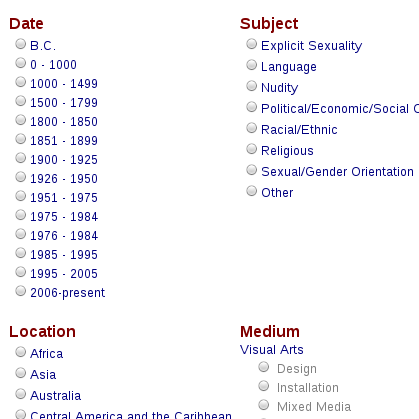
Censored works
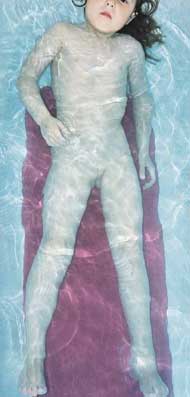 Left: one of 140 works in The File Room censored for "explicit sexuality" - "schutzloses (01)" (untprotected (01)) by photographer Ilona Johanna Plattner. Most of the works listed in The File Room aren't pictured, only described.
Left: one of 140 works in The File Room censored for "explicit sexuality" - "schutzloses (01)" (untprotected (01)) by photographer Ilona Johanna Plattner. Most of the works listed in The File Room aren't pictured, only described.
idea 1
Find original pictures, put one each on USB and encrypt. Like this whole blackout against SOPA thing; imitating the results of the thing you oppose.
And I like the idea of 'entrusting' - like when UHC (Ultimate Holding Company, Mancs) got volunteers to be tattooed with an endangered species and vow to do what they could to try and protect it.
http://www.uhc.org.uk/portfolio.php?tag=13&project=54

idea 2
converting banned images to their code and writing it out by hand. Thus:
����^@^PJFIF^@^A^B^@^@d^@d^@^@��^@^QDucky^@^A^@^D^@^@^@^^^@^@��^@!Adobe^@d�^@^@^@^A^C^@^P^C^B^C^F^@^@^H�^@^@^S�^@^@$���^@�^@$ ^O^W^[^T^P^P^T^[^_^W^W^W^W^W^_^^^W^Z^Z^Z^Z^W^^^^#%'%#^^//33//@@@@@@@@@@@@@@@^A^Q^O^O^Q^S^Q^U^R^R^U^T^Q^T^Q^T^Z^T^V^V^T^Z&^Z^$ �s�H 1��t$���S�t�����&v�面 �94�F^Z^Ez^D^Nڝc\^G��[�ӝ=]g�#k� ��b�g��x�@���6�q��@�u\�P�^Q^G�=��<�0���-4F^A2^P ��5ψW��0Ĉ͈^W=!�̈;�ĈЈ c���&�%F�+��U���u�(�[Tp=<^Yn@9�e�B^OB�^�:�{^L]^Vj�5EH^Qrؘ혰Vgh��g0M^Zۤ`~^D�-ڶ�뀵;"�*Rda髚D�AЫ-^Xt�4��NZy߫F���ѥ(j��h^@[�^E$䥚=k$
��u�F;�^Du^[^ST.r��Q:kZ����ȯ@ίK��"x�w}�ί9ǯU:[ ^V��^Si��Cgj�yכ�_@��^K�. ƛ&H֛N��K^L�5N��Sz4;��цӜǜ^O[��)^Üs^T- C��yלȜ_�c�MfK^Pnz���i^L�Rf�眳u^B7ON�*\�b蜳^A�Y%G\䜳�5^^�g�c�$ t�=�:^Z+�,^W&d�^R�=^G�{F��,�i^A�� �/JF(ִ�Y�ZѴô괳�^DZ�e�gִ-�ֹ\�ӽV%햳�ۖRr疳\`^R���^Y햳(}^Z^Ey㖳�]$��㧂ݧY^_^_1I֧�.�̧˧^Q�B�i�]5�ާrWq���Ч٧蓼\:��^Wϧs观�̎�R� �^\ת(وՓ�X�ϖ�^U&$ ����g���K^V^C�}^B^X����^C�^P�^ZL�0�5ǁ^G��ہ��a�g���́C��^?^CЁ|^_^@C^DX&<^\ß^Gɟ��L���0z^V^Hf4���䟳ğ��^XN�y"/��ƃЃ`��a�=^Gԃ}��~<��$ R��^F0�^Dq�����^O&bg^Q�^H}��1^W3^X��ɌaƌIȄJƄ^E��Yʈ|9�؈^LψĈ&!Ȉ5^Fm�`��X=戳!�4^^�{�'RÈW^X���Ј2؈ۈ^H&^O^F'숳㈳V�^BcP%^_��fẗ̈0^\^W�$ �^C���qx�'_ϫ��ȣ jIi�BAzΣP .�^Tm5۬f Zs �^^۫i˱,^\;�Ա �#�U�E^\�@�;>б^FTձ^Qj��챳�&���ı(ڱct]"�ر̱K8�����%HL�ԋx�o S�Vz^O^_�Eʩ�V��۩p�uv�ͩݏ $MEJ̏ݏo^C�g^YُR�Vɏmf��"�B�!Ec�j$ d�]�/����WFF^G^F^US^^2�eZV^F�F��t#�^@��k�+��z�ZE<^ �:��^F�^K�Xz��X^U�^ZZ�4����oȹH^A�n3�N��XFCVJ�e^EX Ue��9U-��MR�AL^EB��H^Z����p�VT*�Y^T��פK�餳uܤe�ꤳ^YR>¤~B3^RC�^V�i` )^O��Ԙ^?昳T�W�И�ZԘ7��Ø^_m�#טzG9D� ��䘳\ט:ҩɧ"�Ê��v�R�5q$ '^S^N������q� TL0�R^X�^Zm`{&-{�GM�4ܸU^L�Q2ɸU[^Uؕ�T8֕ѨQ;^Z~ڨ^UL먳u^]�^Azͣ�^Tfݰh>^Dl`Q^V^D
- jZ��^P�'_��
- ^Fw5���M�^�R3��^X�����E�0�u
�� #�^Nh�vXj4#^A^Kh�^X����(��2A�o^AA5.G�^@�^N^T�W�mH��4��^L��VWw[���^Rí��[� 4و^Qv���M�Ȉ*�:�^WR�T�눳^C )��R^Aݽ�Ľ^E^X}g^C$ �^Q?k�-�U�!��k^A�p��%�ʉ^U ��E[뉳 �ع^]�0��� İa�qSl$�ۢ}���(?ɝA9 䝳.^V�P�Z���ۨ��^P֨s ^FۨJ^V^H^KCqE��-�^Ko&˨/먳_7�^R��^SV.ۨGm�$ �3^Y^A^]�^?O^Uo�8���k��^Q�j$Kgf�� '\3~���~�*Co^DE3� q�U��^F�^AZ�^Tf-����^H^]�(�*A�r6YE�`F^[Q��N�^G���^�y^Hq^Gͬa�?1��9쬳G��I ��Q�+>��/�l�6�^K[vܨ��^B�MU���,p����3�ۨ\^L���稳\͡��U衳[��^Ej.�ꡳۡ)K^Rv�^[^W^ڡ殥`^Pٮ�6N���I��R�r��a�뮥�ήP^\�-^G��^C�:n^L@��t囚ߛ웚2$
According to Nano. <QUESTION> How do I get the actual code without the failures to display here?
idea 3
Split banned images up into pixles, viewable one by one as coloured divs on a webpage. do it now.
Fri 13 Jan
Just read fascinating Derrida extract, from Archive Fever. I knew all that Freud I was reading over the holidays must not have been totally irrelevant! Love the way it links archives to Freudian theory of memory. Also the clear descriptions of the archive's essential features: that it must A. be situated in place, B. be guarded, and C. be curated - all features which tie it inherently to institutional power.
This definition makes much clearer why it's so radical to refer to, eg, The Pirate Bay as an archive. It is not guarded by those in power - in fact, it openly defies power. But, as Hakim Bey said, "the problem of land refuses to go away". And we come nicely back to my research from last trimester, into territory and place, and the way the digital seems to deny or at least forget its ultimate reliance - which it shares with all archives - on a physical home.
Been thinking over the hols about how archives could link to Radical X and other things. "Forbidden Archives" is a nice phrase that Derrida cites. TPB is one. Thinking of the talk by [insert name], the obscenity lawyer, at Sex on Trial - the guy who specializes in defending people who are threatened with jail for posessing (ie archiving) banned obscene content.
So what about encryption? If you've got an encrypted drive full of dodgy stuff to which you don't know the password, are you breaking the law? Had the idea of 'encrypted jewellery'; USB keys with god knows what on them, made into desirable *objects*.
And over the hols too I've been using PENCILS. Like, for DRAWING. yes. I thought it was a guilty pleasure but actually no; the question is - what is the relationship of the digital/virtual to all this ACTUAL STUFF? paper and metal, etc.
Potentially related: I'm making beautiful watercolour portraits out of screenshots of Skype conversations. Don't analyse too much. Just do it.

